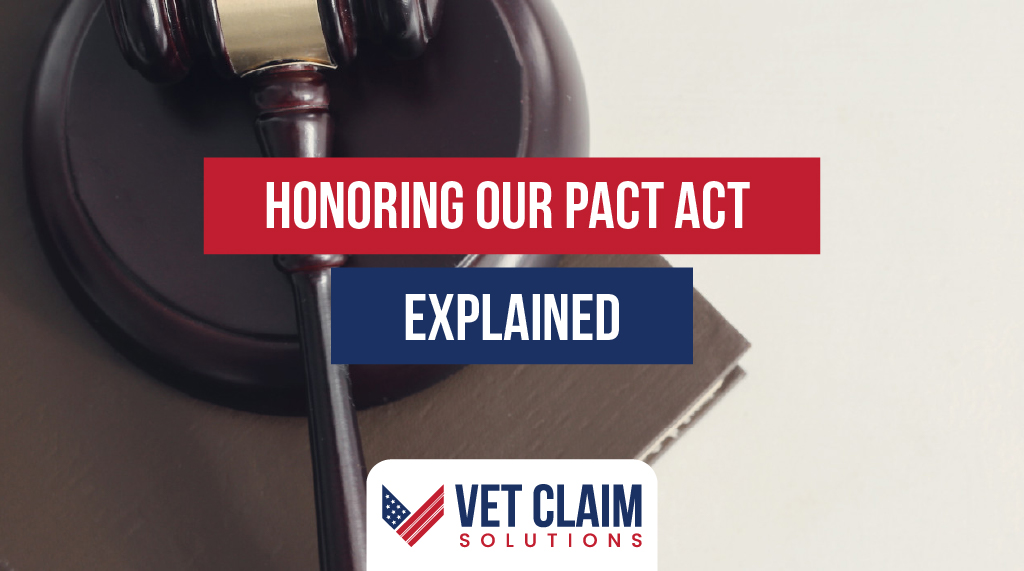The Honoring Our PACT Act of 2022 seeks to aid veterans and civilians exposed to toxic substances. In doing so, it provides medical and financial assistance resources to those affected. The Act is named after Sergeant First Class Heath Robinson, a decorated veteran who lost his life due to toxic exposures he encountered during his military service.
This blog post will explain the specifics of Honoring Our PACT Act of 2022 and how it seeks to help those wounded by toxic exposures. Read on to learn more about this legislation and its potential for assisting veterans and civilians.
What is the PACT Act and its Details?
The Honoring Our PACT Act of 2022 is groundbreaking legislation that provides comprehensive care and benefits to veterans affected by toxic exposures. By allowing the V.A. access to more presumptive conditions, Locations, and Toxic Exposure Screenings, the bill seeks to bring justice to all who have served in the U.S. military.
The PACT Act provides long-overdue protection and access to comprehensive care for veterans who have risked their lives in service of our nation. The enactment of this bill marks a major step forward in ensuring that veterans have the necessary resources to face the challenges of toxic exposure head-on.
The provisions of this Act will:
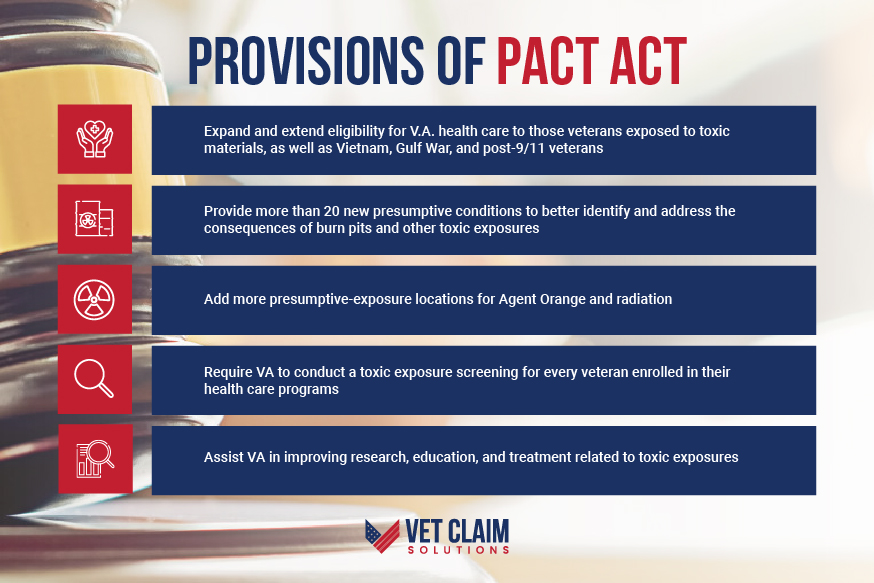
• Expand and extend eligibility for V.A. health care to those veterans exposed to toxic materials, as well as Vietnam, Gulf War, and post-9/11 veterans
• Provide more than 20 new presumptive conditions to better identify and address the consequences of burn pits and other toxic exposures
• Add more presumptive-exposure locations for Agent Orange and radiation
• Require VA to conduct a toxic exposure screening for every veteran enrolled in their health care programs
• Assist VA in improving research, education, and treatment related to toxic exposures
Why is the PACT Act a Major Win for Vets?
The PACT Act is a major victory for Veterans in providing access to care and benefits that are long overdue. For years, toxic exposures have impacted the lives of countless service members without proper recognition or support from the VA. The Honoring Our PACT Act of 2022 seeks to ensure that those who have served our nation receive the resources they need to effectively manage and treat the effects of toxic exposure.
The bill provides broader eligibility requirements for veterans seeking V.A. care and extends benefits to those affected by Agent Orange, radiation, burn pits, and other environmental hazards. It also requires V.A. to offer screenings to all enrolled veterans, which can identify potential toxic exposures that may have contributed to chronic health conditions.
The passage of this Act is a major step forward in ensuring that veterans have access to comprehensive care and benefits for toxic exposure-related conditions. This legislation marks an important milestone for Veterans who now have the assurance that their service-related needs will be addressed and taken care of. The Honoring Our PACT Act of 2022 provides much-needed relief and gives veterans the power to take control of their health and future.
Expansion of Health Care for Veterans of Toxic Exposure

The bill extends healthcare benefits to veterans exposed to toxic substances while serving in the military. These eligible veterans are now entitled to expanded hospital care, such as mental health services and counseling, medical services, and nursing home care for any illnesses related to their exposure.
Additionally, they may receive care if deployed to support a contingency operation, such as Operation Enduring Freedom, Operation Freedom’s Sentinel, Operation Iraqi Freedom, and more.
The bill also provides that the Department of Veterans Affairs (V.A.) must conduct a study to assess access to benefits for veterans living in territories or freely associated states – including Guam, American Samoa, and more. The VA will look at any deficits in the availability and accessibility of these benefits compared to other areas of the United States. This will ensure all veterans receive the care they are entitled to.
Through this bill, veterans exposed to toxins while serving can now access healthcare that can help them recover and improve their quality of life and well-being. The VA is committed to providing these veterans with the care they need and deserve. It’s a small step towards recognizing their sacrifices for our nation.
Developing a Framework for the Addition and Removal of Presumptive Conditions
The VA Presumptive Bill seeks to provide a framework for adding and removing presumptive conditions from the list. The Secretary of Veterans Affairs has the ultimate authority on any changes that need to be made but must go through several steps before doing so. This includes allowing the public to comment on proposed evaluations, seeking advice from a Working Group of personnel from both the Veterans Health Administration and the Veterans Benefits Administration, and implementing regulations within 160 days after receiving a recommendation to establish a presumption.
If an illness is removed from the list, veterans who have already received benefits based on this presumption will not lose their entitlement to compensation. Survivors receiving Dependency and Indemnity Compensation (DIC) benefits will also not have their compensation reduced solely due to the removal of an illness from the presumptive list.
The VA Presumptive Bill provides a structured and transparent process for adding and removing presumptive conditions from the list. It ensures that veterans awarded benefits before any changes remain protected while providing an opportunity for the public to comment and provide input on proposed evaluations. This framework allows the Secretary of Veterans Affairs to make informed decisions on changes that need to be made while ensuring that veterans receive the compensation they deserve.
The VA Presumptive Bill is an important step forward in ensuring that veterans are properly compensated for conditions related to toxic exposures experienced during their military service.
It provides a structured and transparent process for the Secretary of Veterans Affairs to ensure that presumptive conditions are added or removed in an informed manner while protecting veterans who have already been awarded benefits based on such presumptions.
This greatly benefits all veterans and those receiving DIC benefits, as it ensures they will not lose compensation based on changes in the presumptive list. This is important for ensuring veterans receive the compensation they need and deserve for service-related health conditions.
The 23 New Conditions/Illnesses that are now Presumptive to Toxic Exposures
For many veterans, these 23 conditions or illnesses are now presumed to be due to toxic exposure during service. This means veterans can receive disability compensation and healthcare related to these conditions without proving their exposure to toxins in the military. The presumptive list includes:

- asthma diagnosed after service
- head cancer
- neck cancer
- respiratory cancer
- gastrointestinal cancer
- reproductive cancer
- lymphoma cancer
- Lymphatic cancer
- kidney cancer
- brain cancer
- melanoma
- pancreatic cancer
- chronic bronchitis
- COPD (Chronic Obstructive Pulmonary Disease)
- constrictive bronchiolitis or obliterative bronchiolitis
- emphysema
- granulomatous disease
- interstitial lung disease
- pleuritis
- pulmonary fibrosis
- sarcoidosis
- chronic sinusitis
- chronic rhinitis
- glioblastoma.
Location and Periods of Service That Qualify for Presumptive Exposure to Burn Pits
1. A veteran who, on or after August 2, 1990, was assigned to a duty station in the vicinity of one of the following burn pits:
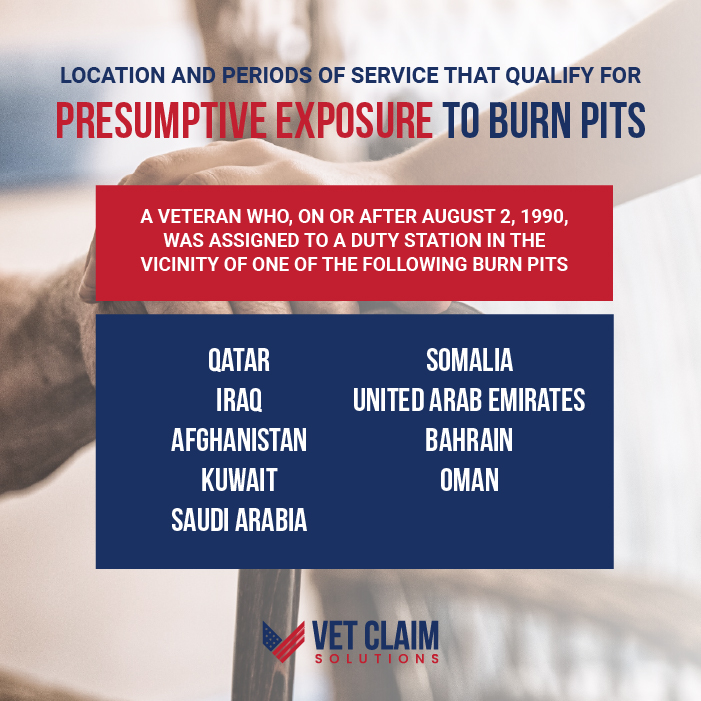
- Qatar
- Iraq
- Afghanistan
- Kuwait
- Saudi Arabia
- Somalia
- United Arab Emirates
- Bahrain
- Oman
2. Veterans who served on or after September 11, 2001, may be eligible to receive presumptive exposure to burn pits if they performed active military, naval, air, or space service while assigned to a duty station in the following locations:
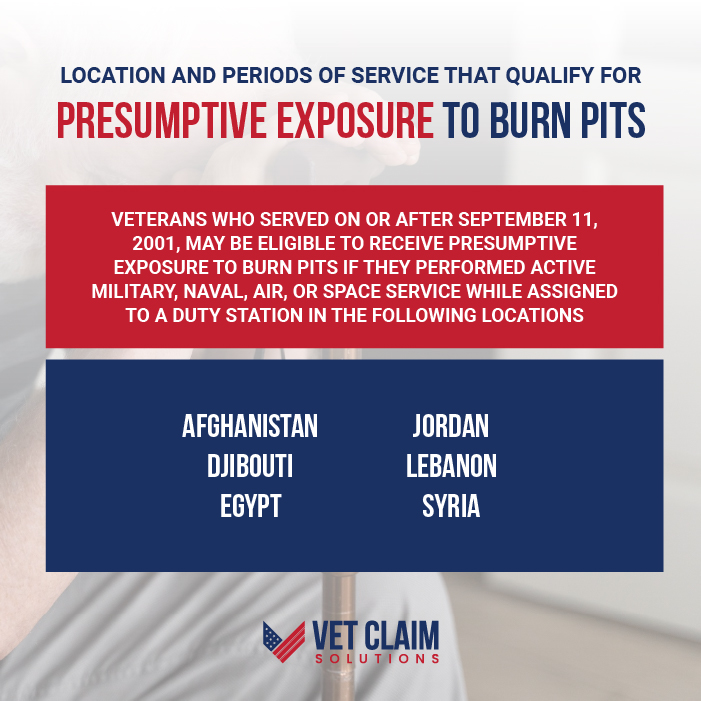
- Afghanistan
- Djibouti
- Egypt
- Jordan
- Lebanon
- Syria
Eligibility of Free VA Healthcare due to the PACT Act
If you served in a theater of combat operations during a period of war after the Persian Gulf War, or if you experienced combat against a hostile force during a period of hostilities after November 11, 1998, and were discharged after October 1, 2013, then you are eligible to receive free V.A. healthcare for up to 10 years from your most recent discharge or separation. This coverage is provided through the Patient Access to Care Treatment (PACT) Act, part of the Veterans Access, Choice, and Accountability Act of 2014.
The PACT Act provides free V.A. healthcare for any condition related to your service during these ten years. If you enroll at any time during this period, you will be able to receive any care that you need, though you may have to pay a copayment for some services. In addition to healthcare, this law also assists in transitioning from active duty service to civilian life and allows veterans who experienced combat-related injuries or illnesses to access specialized V.A. treatment programs.
Vietnam Veterans: New Presumptive Conditions Due to Agent Orange
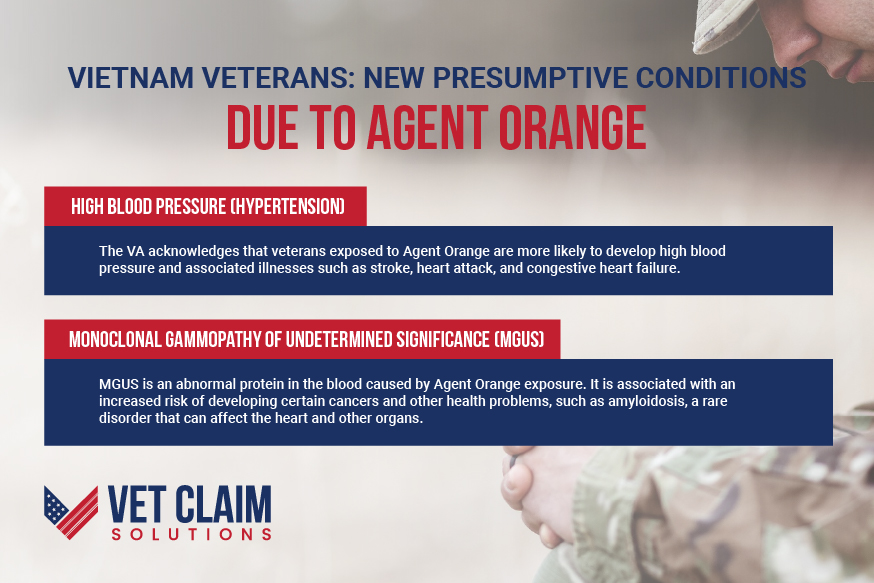
The U.S. Department of Veterans Affairs (V.A.) has determined that certain health conditions are presumptively associated with Agent Orange exposure for Vietnam veterans, providing them with eligibility for disability benefits. These additional presumptive conditions include:
High Blood Pressure (Hypertension):
The VA acknowledges that veterans exposed to Agent Orange are more likely to develop high blood pressure and associated illnesses such as stroke, heart attack, and congestive heart failure.
Monoclonal Gammopathy of Undetermined Significance (MGUS):
MGUS is an abnormal protein in the blood caused by Agent Orange exposure. It is associated with an increased risk of developing certain cancers and other health problems, such as amyloidosis, a rare disorder that can affect the heart and other organs.
Vietnam Veterans: New Presumptive Locations for Agent Orange Exposure

Vietnam veterans may be eligible for disability compensation if they can prove exposure to Agent Orange, a toxic defoliant used during the Vietnam War. The Department of Veterans Affairs (V.A.) has recently added new presumptive locations to their list of areas where Agent Orange exposure is assumed, and veterans are eligible to receive benefits without providing additional proof of exposure. These new presumptive locations include:
Any U.S. or Royal Thai military base in Thailand.
Exposure is assumed for veterans who served in Thailand from January 9, 1962, through June 30, 1976.
Laos.
Veterans who served in Laos from December 1, 1965, through September 30, 1969, are presumed to have been exposed to Agent Orange.
Cambodia
Veterans who served at Mimot or Krek in Kampong Cham Province from April 16, 1969, through April 30, 1969, are considered to have been exposed.
Guam and American Samoa.
Veterans who served in these areas or territorial waters off of them from January 9, 1962, through July 30, 1980, are eligible for presumptive exposure.
Johnston Atoll.
Veterans stationed or served on a ship called Johnston Atoll from January 1, 1972, through September 30, 1977, are considered exposed to Agent Orange.
The VA also has designated three “response acts” as presumptive radiation exposure events:
- the cleanup of Enewetak Atoll from 1977 – 1980;
- the cleanup of a B-52 bomber carrying nuclear weapons off the coast of Palomares, Spain, in 1966 – 1967;
- The response to a fire on board an Air Force B-52 bomber carrying nuclear weapons near Thule Air Force Base in Greenland in 1968.
Veterans who participated in any of these “response acts” are presumed to have been exposed to radiation. Veterans who meet the criteria listed above may be eligible for disability compensation.
Improve Federal Research on Toxic Exposure
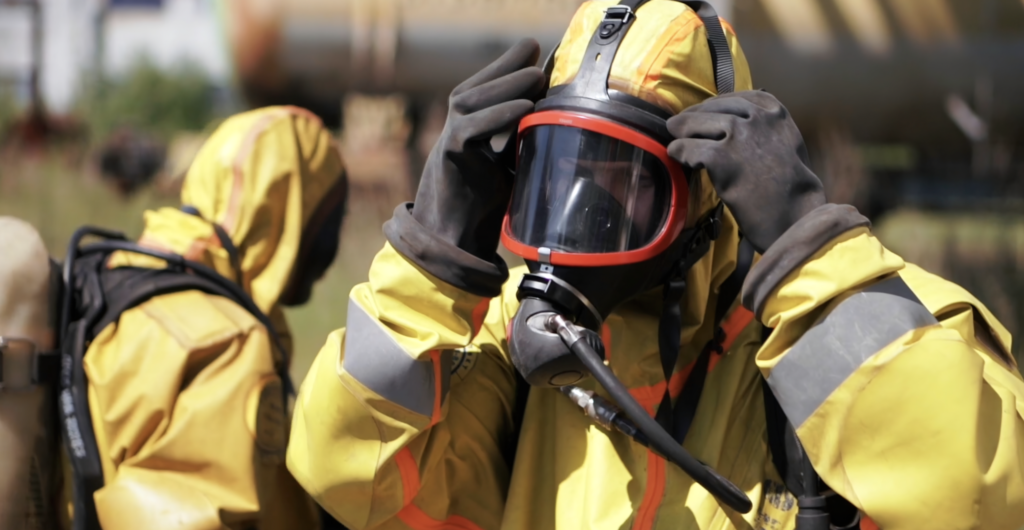
VA is committed to addressing toxic exposures experienced by veterans during their military service. To this effect, the Department of Veterans Affairs will partner with the National Academies of Sciences, Engineering, and Medicine to assess potential relationships between toxic military exposures and mental health conditions. These conditions include:
- chronic multisymptom illness
- traumatic brain injury (TBI)
- post-traumatic stress disorder (PTSD)
- depression
- episodes of psychosis
- schizophrenia
- bipolar disorder
- suicide attempts.
The bill also requires V.A. to establish and maintain a public website for toxic exposure research to coordinate with the War-Related Illness and Injury Study Center of the V.A.
Furthermore, a list of resources and an outreach program must be published to provide information to veterans exposed to toxins in service, as well as their families, caregivers, and surviving dependents.
V.A. is also mandated to launch two more research initiatives – the health effects of jet fuels and the health effects of Fort McClellan Exposure. For jet fuels, a public report must be issued indicating which fuel was used, where it was used, safety measures taken, and the effects on service members based on length of exposure.
An epidemiological study must examine veterans’ health trends at Fort McClellan between January 1, 1935, and May 20, 1999. The VA is committed to improving research on toxic exposure for the benefit of our veterans and their families. Through these initiatives, V.A. hopes to gain valuable insight into the risks of military environments and ensure that our veterans receive the best care possible.
Improve VA’s Resources, Training, and Investment in V.A. Claims Processing, Workforce, and Facilities for Healthcare
The PACT Act aims to improve resources, training, and investment in V.A. claims processing, workforce, and facilities for healthcare. With this legislation, veterans will now have the option of receiving V.A. communication electronically.
Additionally, funding from the Cost of War Toxic Exposures Fund will be used to develop an automated claims processing system with enhanced capacity. The Act also calls for V.A. to help veterans update their records to reflect exposures to occupational or environmental hazards, if necessary.
To further improve the V.A. workforce, the legislation offers instructions on implementing a national rural recruitment plan and other workforce modifications. All of these changes are significant steps towards improving healthcare and services for veterans.
Required Outreach by the V.A.
The law also requires the V.A. to issue outreach and education materials to inform veterans about toxic exposures in military service, including information on filing a claim for disability due to radiation exposure.
The bill also calls for the V.A. to create a public website that provides detailed information on health risks associated with radiation exposure. V.A. is further mandated to work with state and local governments to provide health screenings for veterans that meet the criteria for disability compensation due to radiation exposure.
The VA must also set up a registry of veterans who may have been exposed to toxic substances during their military service and inform them about potential health risks associated with those exposures. By increasing awareness of the dangers of toxic exposure, the V.A. is working to ensure veterans get the care they need.
Potential Benefits for Survivors
Spouses, dependent children and potentially even parents of the deceased veteran may qualify for certain benefits from the VA if the veteran was rated for service-connected disabilities. Even if the veteran has passed, the beneficiaries should still look at filing on behalf of the veteran as benefits may still be paid to them posthumously.
These benefits may include the following:
- Dependency and Indemnity Compensation (DIC) which is a monthly tax-free stipend paid to the spouse (and possible dependent children or parents) if the veteran passed away from a service-connected condition. The 2023 rates for DIC is $1,562.73.
- A one-time payment for any accrued VA disability compensation paid to the spouse (and possible dependent children or parents) that the veteran did not receive. This payment is usually made lump sum.
- A monthly Survivors Pension if the veteran served in wartime.
- Additional benefits may include burial insurance, VA home loan eligibility and job and educational benefits for the spouse (and possible dependent children).
Need Help Filing a Claim Related to the PACT ACT?
If you are a veteran and need assistance filing a claim related to the PACT Act of 2022, we can help. Our team at Vet claim solutions is here to provide support throughout the entire process. We understand what it takes to get approved for benefits and will do everything possible to ensure your claim is handled correctly.
Conclusion
the PACT Act of 2022 is an important piece of legislation that addresses comprehensive toxic exposure risk activity and expands V.A. health care services for veterans. The law requires the V.A. to issue outreach materials and create a public website detailing radiation-related health risks. Additionally, it creates an exposure tracking record system and educational programs to increase the V.A.’s understanding of toxic exposure. With the PACT Act in place, veterans should be able to access more comprehensive services and benefits related to their exposure.
FAQ

What was in the PACT Act 2022?
The PACT Act of 2022 was signed into law by President Joe Biden on April 22, 2022, and allows veterans to receive compensation for any health issues due to military environmental exposure. It also requires the V.A. to update its records to reflect exposures to occupational or environmental hazards and establish a national rural recruitment plan and other workforce modifications.

What changed in the PACT Act 2022?
The PACT Act of 2022 expands on the original law to include more veteran benefits and services. It requires the V.A. to issue outreach and education mater to inform veterans about toxic exposures in military service, provide veterans access to additional services and benefits related to toxic exposure, and set up a registry of veterans who may have been exposed to toxic substances.

How much will the PACT Act pay?
The amount of compensation a veteran can receive varies depending on the severity of their injury and other factors. Generally, veterans may be eligible to receive up to $100,000 in compensation. However, speaking with a qualified V.A. representative is important to determine the exact amount.

Who qualifies for the PACT Act?
Any veteran who served in the military and has experienced health problems due to exposure to toxic substances may qualify for benefits and services under the PACT Act of 2022. It is important to speak with a qualified V.A. representative to determine eligibility for these benefits and services.

What is the Veterans Benefits Administration (VBA)?
The Veterans Benefits Administration (VBA) is a division of the U.S. Department of Veterans Affairs (V.A.) responsible for administering benefits and services to veterans, including disability compensation, pension, education, home loan guarantees, and vocational rehabilitation.

How does the Comprehensive Toxics Act (PACT) of 2022 expands VA health care?
The PACT Act of 2022 expands V.A. health care by requiring the V.A. to issue educational materials about toxic exposures in military service, create a public website with detailed information about health risks related to radiation exposure, provide screenings for veterans who may be eligible for disability compensation due to toxic exposure, and create a registry of veterans who may have been exposed to toxic substances.


